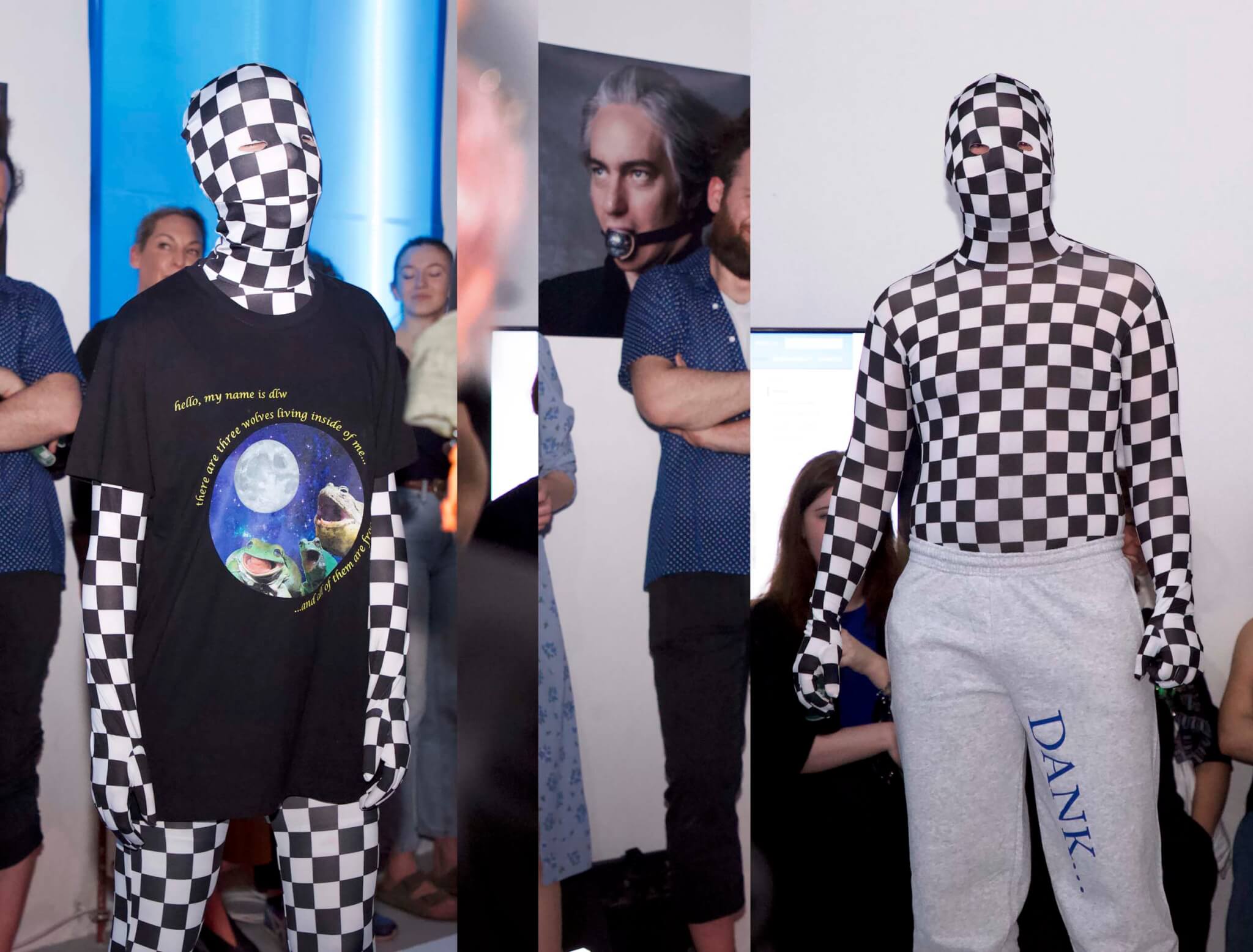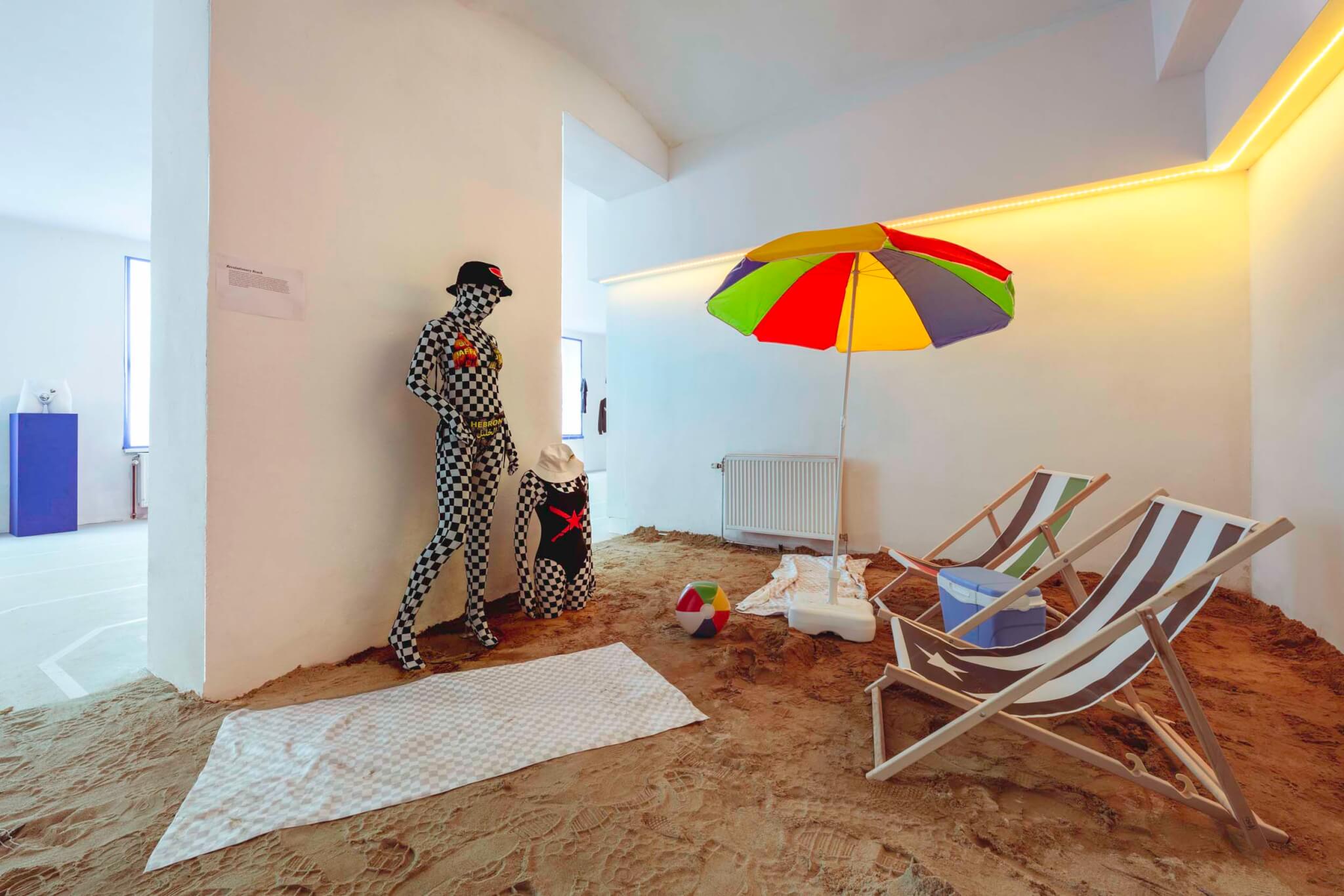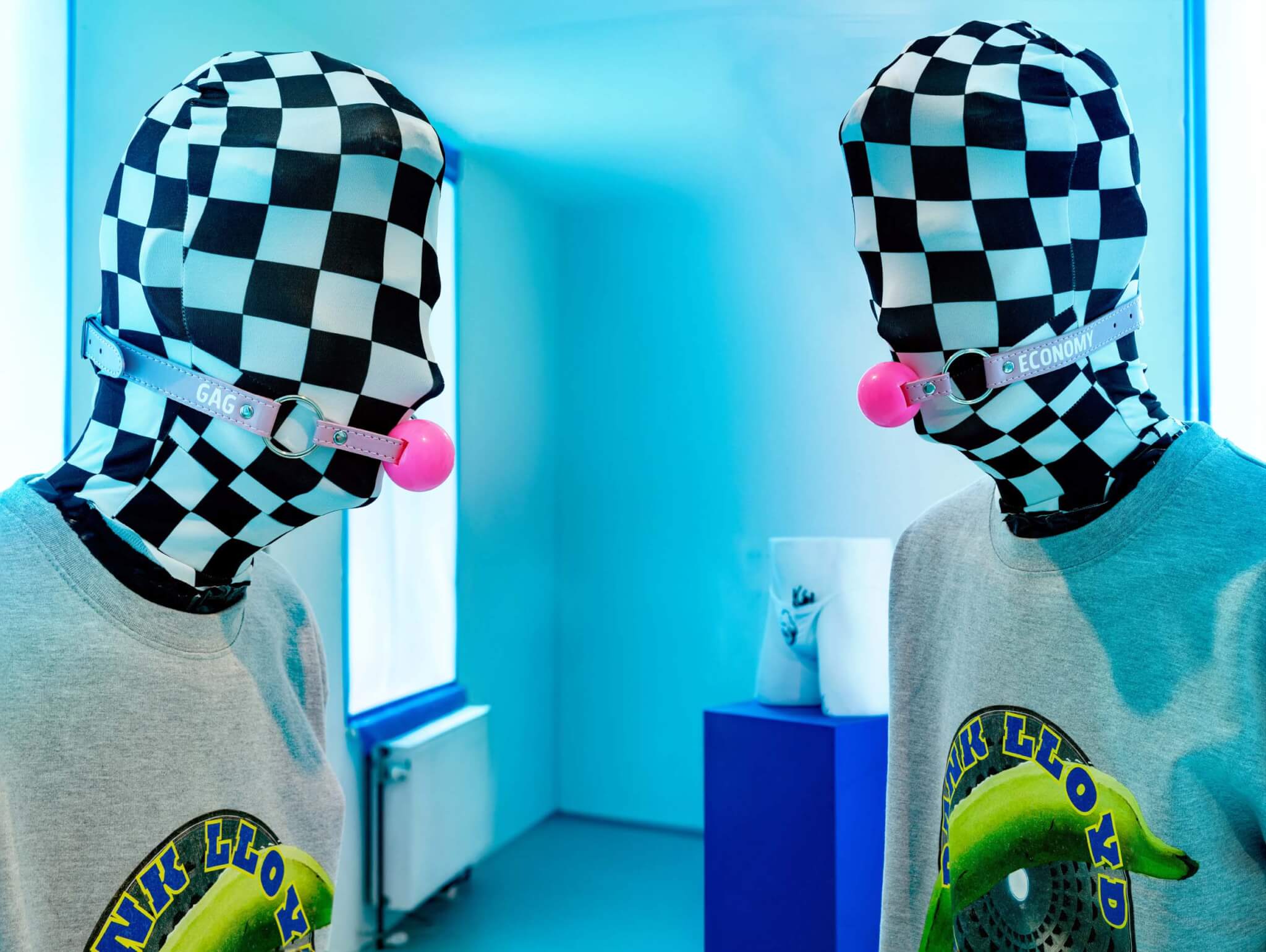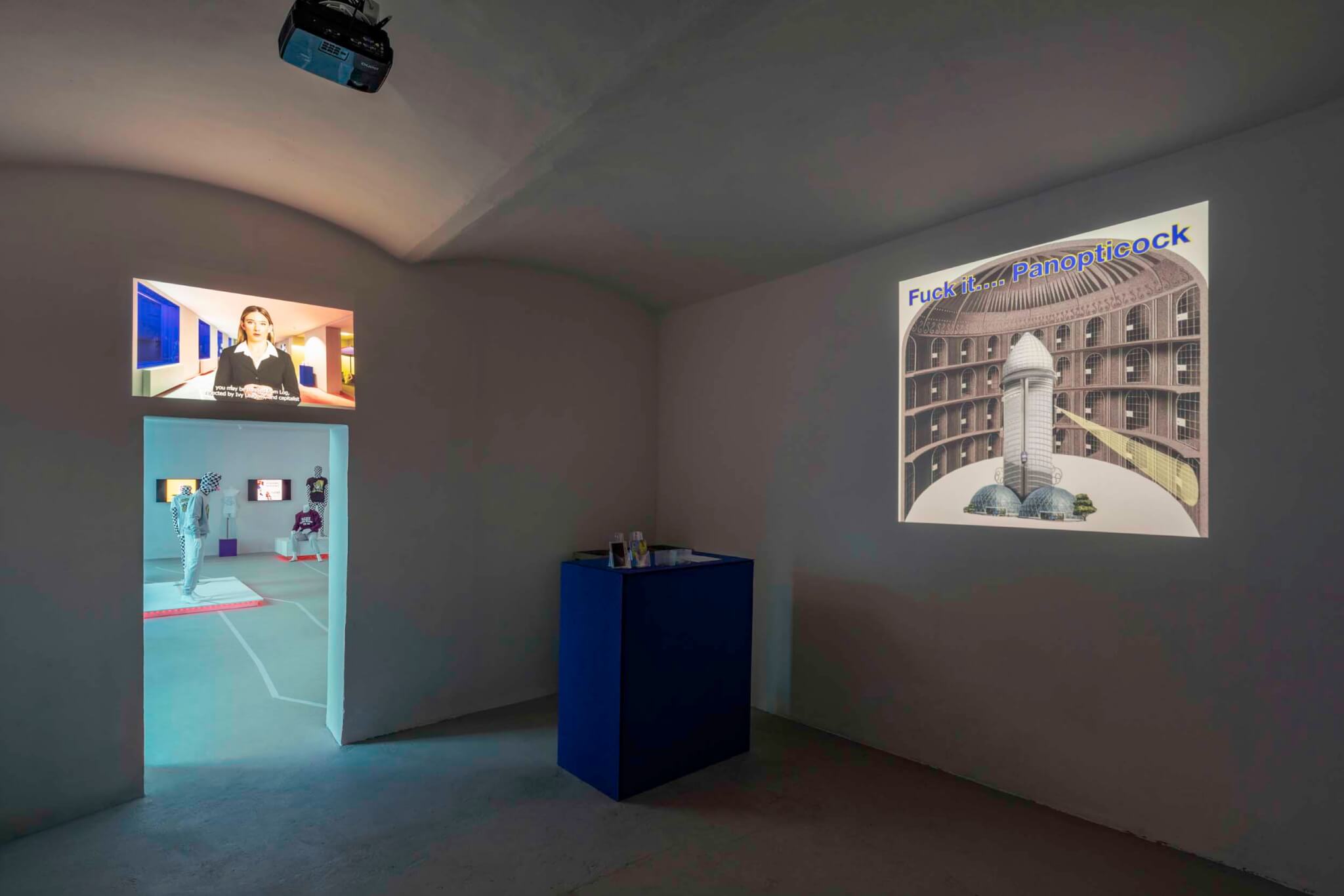Gag Economy
Magazin
Vienna
June 17–July 28
I’m in a dollar store. I’m in a space for contemporary architecture. I’m in a dollar store space for contemporary architecture. There are products, but there is nothing to buy. I’m laughing, but I think I might be the punchline. Maybe I want to cry.
I’m at Gag Economy, Dank Lloyd Wright’s (DLW) debut exhibition at Magazin, a contemporary architecture space in Vienna. Self-described by its anonymous admins (a.k.a. “ants”) as an “emerging theorist proletarian psy-op,” DLW is an Instagram feed whose grid is a patchwork of ridiculous Photoshops, terrible jokes, and heartfelt demands for… what, exactly? At least something better than we have now. On the one hand, communism! On the other, just a good night’s sleep.
The bad Photoshops, collages and slogans it (they?) makes (make?) sit somewhere between critique, manifesto and, yes, gags. They call out bad practice, hyperbole, and the generally tragic state of architecture. They aim high at architecture’s most vainglorious grandstanding, but also at the profession’s everyday grind from the point of view of its labor force. The show offers both insider gossip and jokes landed from a point of view at architecture’s periphery.

DLW’s memes use a medium whose frivolous, cartoony, amateur, and shonky nature is inherently oppositional to typically high-falutin’ academic or po-faced monographic architectural modes. Memes have not, as yet, been established as a legit form of architectural communication—but they should be.
DLW’s memes float in the empty void vacated by criticism. Maybe they are a response to a world where there are no critics left to hold architecture (or architects) to account. The old media economy that supported the 20th century critic—the internet plus the collapse of advertising revenue post-2008—is gone, along with the era’s particularly elevated idea of discourse.

For better or worse, there are no longer public figures who act as gatekeepers (I guess that was bad?) or moral guides (Maybe that was good?). What’s left in the media is often a kind of apologia for architecture with headlines that usually run something like this:
“[Firm X]’s new [adjective] [word for building] has [crashed/poked/completed/thrusted/etc.] in [location].”
As in: Today, the “media” offers a form of writing that supposedly translates architecture for general consumption which is descriptive rather than critical. This inevitably means it simply regurgitates known knowledge (often parroting a press release) and is unable to challenge, reinvent, cajole, or reject the prevailing sentiment. This action in turn constricts the idea and possibility of architecture because it must conform to existing widely held popular ideas of what architecture is or who architects are.
For a hot internet minute, the blogosphere (RIP) acted as a critical space that accelerated a new range of voices, positions, and ideas in a loose-knit array of discourse. But it ran into sand when everyone stopped writing for free to become respected authors, designers, or otherwise got proper jobs. Meanwhile, a generation of journalist-critics jumped ship to become curators as print’s decline continued.
Without critics, architects have been left to say whatever they want. What passes for discourse is now a stream so polluted by toxic self-promotion, PR runoff, and the effluent of liberal platitudes that it’s become less than useless.

It’s not only the hubristic so-called “stars,” the ones still churning out overblown baubles for dubious regimes. It’s all of us. “We love community,” declares the architects whose palms are crossed with, say, Lendlease silver. “Play!” says the least playful of all. Generic claims about sustainability are the last refuge of the if-not-scoundrel then at least the architecture office that wants to get ahead. Shameless appeals to corporate responsibility are made worse by the sincerity with which they are spoken, even when they are cut loose from any tangible connection to architecture either as an art or its social reality. The cognitive dissonance is deafening.
While we may be pleased with ourselves for overthrowing the oppressive tyranny of the old-school critic, we find ourselves adrift in a media-void of our own making: Content goes un(fact)checked and unquestioned; one’s positions are so weak that they just become locations; and cosplay arguments wear thin. No direction home.
Back at Magazin, with the memelords-turned-designers (or designers-turned-memelords?), this experiment in criticism looks like this:
A space is set up for a fashion show, with a runway circuit marked out in tape. There’s translucent blue plastic covering the windows, giving the space the tint McDonalds used to stop people from shooting up in their toilets. Showroom dummies in checkerboard onesies are decked out in DLW antimerch, sporting ball gags strapped over their mouths—perhaps performing architecture’s desire for submissive muteness. A kind of festival-meets-fetish vibe is encouraged by cut-price, Leigh Bowery Halloween outfits. Posed on white plinths and underlit with LED strips, these designs that usually aspire to fast-floaty-fashion flashiness here are undermined by the dirtiness of the reclaimed material they are made from.

In one room, you can relax on a beach complete with sand underfoot. But the scene has a sense of anxiety. The loungers are decked out in Palestinian and Puerto Rican flags. The scenography, DLW suggests, “slows down time to acknowledge ongoing struggles for liberation that are always at odds with architecture as a tool of development and occupation.”
Elsewhere we are partying in a Karl Marx G-string with a plastic ant poking out, an assembly that is somehow “political.” Am I pleased to see you or is that just a suggestively placed skyscraper in my track pants? Leafing through a Hello!-style magazine reveals parodies that attack architecture’s individualist celebrity: Tom Wiscombe’s already ridiculous portrait is augmented with a ball gag, and photo of David Adjaye shows off an honor that hasn’t aged at all well. (The publication includes Anne Holtrop, who perhaps did something wrong to feature amongst this low-hanging and overripe fruit; it’s hard to keep up with architecture’s myriad global indiscretions.) Some of the targets are so overripe that they’ve been dead a while already.

At Gag Economy, memes become objects that become memes. Or maybe objects have always been memes? Is architecture congealed information? Or frozen ideology? Are buildings forms of political media embodied in the fabric of the world? Is it possible to produce architecture under current ideological regimes that does anything else but reproduce that ideology in ever more concentrated form?
DLW’s anonymous voice reminds us of our complicity in the media-economic-political complex that architecture operates within (and perhaps always has). It’s a necessary voice because architecture without discourse is not only just building but simply an operation of capital. These are serious messages communicated through “unserious” media—whether that’s Instagram posts or print-on-demand t-shirts—that reverses architecture’s typical mode: Puerile messages communicated through the gravitas of built form.
Sam Jacob is director of Sam Jacob Studio for architecture and design in London and is a professor at the Angewandte, Vienna.











